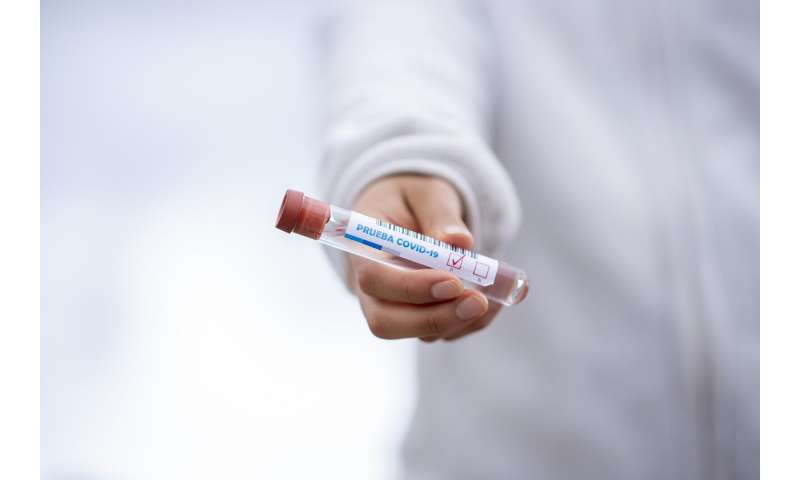
New research from Wuhan, China shows that, in patients with COVID-19 but without a previous diagnosis of diabetes, abnormally high blood sugar is associated with more than double the risk of death and also an increased risk of severe complications. The study is by Dr. Yang Jin, Union Hospital and Tongji Medical College, Huazhong University of Science and Technology, Wuhan, Hubei, China, and colleagues. The study is published in Diabetologia.
Previous studies have established that hyperglycaemia (abnormally high blood sugar) is associated with an elevated risk of mortality in community-acquired pneumonia, stroke, heart attacks, trauma and surgery, among other conditions. A number of studies have also shown links between diabetes and poor outcomes in COVID-19 patients. However, direct correlation between fasting blood glucose (FBG) level at admission to hospital and clinical outcomes of COVID-19 patients without diagnosed diabetes has not been well established. In this new study the authors examined the association between FBG on admission and the 28-day mortality of COVID-19 patients without previously diagnosed diabetes in two hospitals.
The retrospective study assessed all consecutive COVID-19 patients with a known outcome at 28-days and FBG measurement at admission from 24 January 2020 to 10 February 2020 in two hospitals based in Wuhan, China. Demographic and clinical data, 28-day outcomes, in-hospital complications and CRB-65 scores of COVID-19 patients in the two hospitals were analysed. The CRB-65 score is an effective measure for assessing the severity of pneumonia and is based on four indicators: level of confusion, respiratory rate (over 30 breaths per min), systolic blood pressure (90 mmHg or less) or diastolic blood pressure (60 mmHg or less), and age (65 years or over).
A total of 605 COVID-19 patients were enrolled, including 114 who died in hospital. The median age of participants was 59 years and 322 (53.2%) were men. A total of 208 (34%) had one or more underlying conditions (but not diagnosed diabetes), of which high blood pressure was the most common. Almost one third (29%) of patients fell into the highest category of FBG on admission (7.0 mmol/L) which if found consistently would result in a diagnosis of type 2 diabetes. A further 17% were in the range that would be considered pre-diabetic (6.1-6.9 mmol/L), while more than half (54%) were in the ‘normal’ FBG range of 6.0 mmol/L or below.
The results showed that patients in the highest FBG group were 2.3 times more likely to die than those in the lowest, a statistically significant result. Those in the middle (pre-diabetic) FBG group were 71% more likely to die than those in the lowest group, although this result only had borderline statistical significance. The data also showed that men were 75% more likely to die than women; and that patients with higher CRB65 scores (and thus worse pneumonia) were also at higher risk of death: those with a score of 3-4 were more than 5 times more likely to die than those with a score of 0, while for those with a score of 1-2 there was a 2.7 times increased risk.
When looking at FBG and CRB65 scores together, the patients in the highest FBG group had an increased risk of death compared to the lowest, regardless of whether or not the CRB65 score was zero or higher, further underlining that FBG independently increases the risk of death in COVID-19 patients. However, the increased risk of death for the highest FBG group was lower in patients with CRB65 scores of above zero compared with those with a CRB65 score of zero. The risk of complications was also found to be 4 times higher in the highest FBG group compared to the lowest, and 2.6 times higher in the middle (pre-diabetic) group compared to the lowest.
The authors say: “This study shows, for the first time, that elevated FBG (>7.0 mmol/l) at admission is independently associated with increased 28-day mortality and percentages of in-hospital complications in COVID-19 patients without previous diagnosis of diabetes… we have also shown that FBG of 7.0 mmol/l or higher is associated with increased mortality, regardless of whether the patient has pneumonia that is more or less severe.”
They add: “These results indicate that our study included both undiagnosed diabetic patients and non-diabetic patients with hyperglycaemia caused by an acute blood-glucose disorder, since the 29% found in the highest FBG group is much higher than the estimated prevalence of diabetes in the Chinese population at 12%. Similarly to what was found in a previous study, COVID-19 patients might suffer from high blood sugar brought about by other conditions, and critically ill patients may develop acute insulin resistance, manifested by high levels of blood sugar and insulin levels. Patients with conditions not related to diabetes, such as severe sepsis, systemic inflammatory response syndrome (SIRS) and traumatic brain injury tend to have abnormally high blood sugar.”
The authors note several limitations with their study. First, this was a retrospective study. Second, they did not analyse glycated haemoglobin (HbA1c), a long-term blood sugar control indicator that helps distinguish patients with poor long-term blood sugar control from those with stress hyperglycaemia. Also, they did not have sufficient data to study the effect of glucose-lowering treatment (e.g. insulin, metformin) on the outcome of the patients in their study. However, they believe that acute hyperglycaemia is more important than long-term glycaemic control in predicting the prognosis of hospitalised COVID-19 patients.
The authors suggest that possible mechanisms for this increased mortality include hyperglycaemia-induced changes in coagulation (clotting), worsening of endothelial function (the function of the walls of blood vessels), and overproduction of inflammatory cytokines produced by the immune system (the so-called cytokine storm).
Source: Read Full Article
